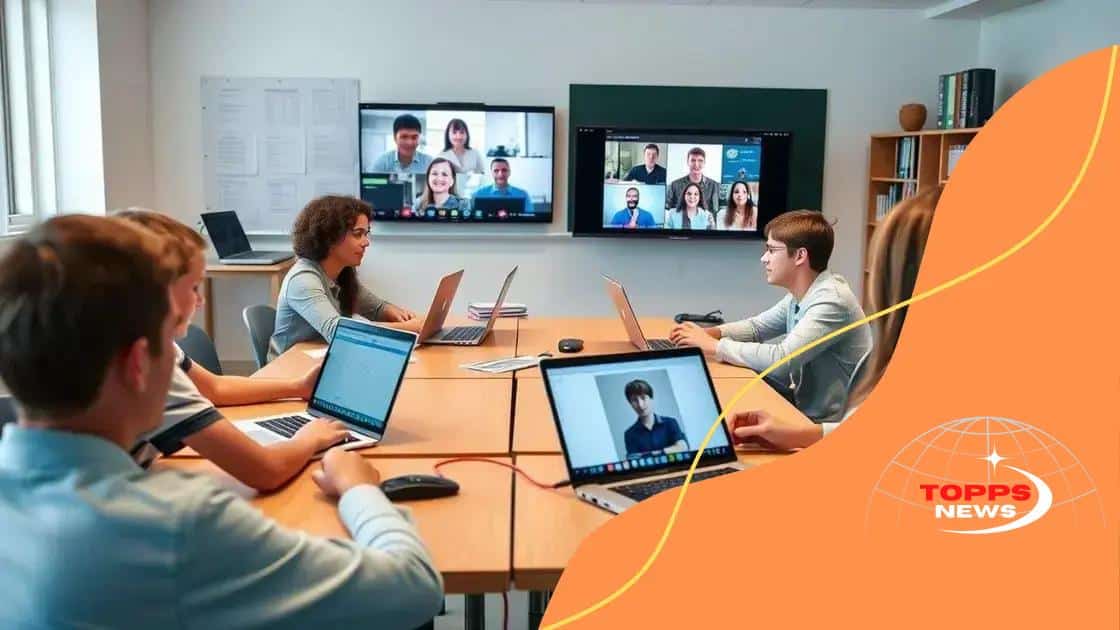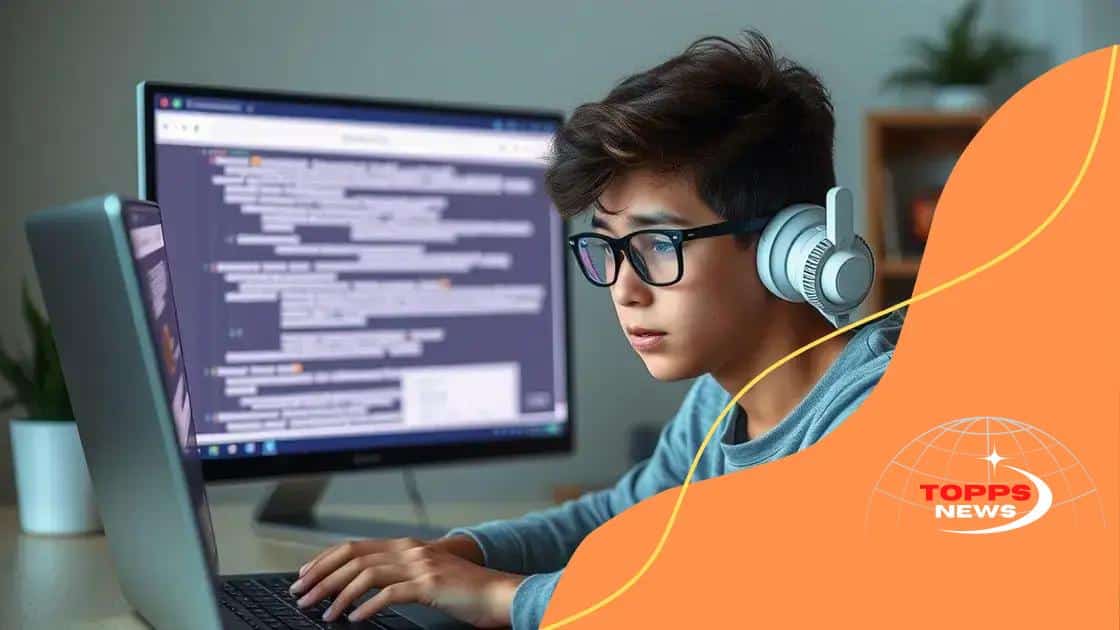The impact of virtual classrooms on student collaboration

The impact of virtual classrooms on student collaboration is significant, enhancing communication, accessibility, and teamwork, while also introducing challenges like technical difficulties and communication barriers.
The impact of virtual classrooms on student collaboration is shaping how learners connect and engage today. Have you noticed how technology changes the way we learn together? In this article, let’s dive into the dynamics of collaboration in these digital settings.
Defining virtual classrooms and their features
Virtual classrooms have transformed the way education is delivered, allowing students to learn from anywhere. By providing a flexible learning environment, these classrooms offer new opportunities for student collaboration and engagement.
What Are Virtual Classrooms?
A virtual classroom is an online space where instructors and students interact in real-time. They utilize various technologies to create an immersive learning experience. Some key tools include:
- Video conferencing software
- Discussion forums
- Interactive whiteboards
- File-sharing applications
These features help build connections among students, encouraging teamwork even when they are physically apart. With virtual classrooms, learning is not limited by location, making education more accessible.
Key Features of Virtual Classrooms
There are several features that define a virtual classroom. Some of these features enhance collaboration and engagement:
- Real-time communication: Students can ask questions and participate actively during lessons.
- Interactive learning tools: These tools make lessons more engaging and help with understanding complex topics.
- Flexibility: Students can join classes from any location, making it easier to balance life and study.
The flexibility of virtual classrooms allows students from different backgrounds to collaborate and share diverse perspectives. As technology continues to advance, we can expect even more features that enhance collaborative learning experiences to emerge.
Benefits of collaboration in virtual learning
Collaboration in virtual learning has many advantages that enhance the educational experience. By working together, students can develop important skills that will benefit them in the future.
Enhanced Communication Skills
One key benefit of collaboration is improved communication skills. In a virtual setting, students must express their ideas clearly. They learn to communicate effectively through written messages and video chats, which is essential in today’s world.
Access to Diverse Perspectives
When students collaborate in virtual classrooms, they often work with peers from different backgrounds. This exposure allows students to hear various viewpoints and develop critical thinking skills. They learn to appreciate diversity, which enriches their educational journey.
- Broadened understanding: Engaging with diverse peers helps students see issues from multiple angles.
- Increased creativity: Collaborative projects encourage innovation as students share different ideas.
- Better problem solving: Working together enables students to approach challenges creatively, combining their strengths.
Through collaborative learning, students develop a sense of community, even in a virtual environment. This community will help them feel connected and supported, which can enhance their overall learning experience.
Improved Technical Skills
Another major advantage is the improvement of technical skills. Students must navigate various online tools to collaborate, which enhances their digital literacy. This proficiency is crucial for success in both education and future careers.
Learning how to use these technologies effectively also prepares students for the workforce. Many jobs today require strong collaboration skills, and virtual learning environments give them a head start. They learn to use tools like video conferencing, file sharing, and online forums fluently, making them more competitive in their future endeavors.
Challenges faced by students in virtual environments

While virtual learning offers many benefits, students also face several challenges. These challenges can affect their ability to collaborate effectively and succeed in their studies.
Technical Difficulties
One of the major issues students encounter in virtual environments is technical difficulties. Problems like poor internet connectivity can disrupt learning. When students cannot join classes or access materials, it impacts their education. Moreover, some students may struggle with the tools used in these settings.
- Learning curves: Adapting to new technologies can take time and effort.
- Equipment access: Not all students have access to the necessary devices.
- Software issues: Problems with applications can lead to frustration during class.
These technical challenges can create barriers to effective student collaboration. When technology fails, learning suffers.
Communication Barriers
In a virtual setting, communication can be less direct than in face-to-face interactions. Students might feel isolated or disconnected from their peers and instructors. This feeling can hinder their confidence and willingness to participate. They may avoid contributing to discussions due to fear of being misunderstood.
Moreover, the lack of non-verbal cues can complicate interactions. Students miss out on body language and facial expressions, which are important for effective communication.
Time Management Issues
Another challenge faced by students involves managing their time effectively. In a virtual classroom, students often have more flexible schedules. However, without the structure of a physical classroom, it can be easy to procrastinate or become distracted.
Students may struggle to stay organized and prioritize their tasks. This can lead to missed deadlines and increased stress. To succeed in this environment, they must develop strong time management skills.
These challenges emphasize the need for support systems in virtual classrooms. Schools and educators should provide resources and guidance to help students navigate these obstacles successfully.
Tools that enhance collaboration among students
To support collaboration in virtual learning, many tools are available that enhance communication and teamwork among students. These tools make it easier for students to connect, share ideas, and work together on projects.
Video Conferencing Tools
Video conferencing platforms are essential for real-time communication. They allow students to participate in discussions as if they were in a physical classroom. Some popular options include:
- Zoom: Offers features for breakout rooms, enabling small group discussions.
- Microsoft Teams: Integrates with other Microsoft applications for collaborative work.
- Google Meet: Provides easy access for students using Google accounts.
These tools help students feel more connected and engaged during lessons, promoting a sense of community.
Collaboration Software
Collaboration software is another important category. Programs like Google Workspace and Microsoft 365 allow students to work together on projects in real time. They can edit documents, spreadsheets, and presentations simultaneously. This functionality encourages teamwork and helps students learn how to work effectively in a group.
With cloud storage options, students can access their work from any device, facilitating continuous collaboration. Additionally, these platforms often include features like commenting and version history, so students can track changes and provide feedback to one another.
Online Discussion Boards
Discussion boards serve as a space for students to share their thoughts and ask questions outside of live sessions. Platforms like Padlet and Google Classroom enable students to post ideas and respond to their peers. This asynchronous communication allows for deeper reflection and helps students articulate their thoughts.
Using these tools encourages participation from students who may be shy in face-to-face settings. By engaging in written discussions, they can express their ideas more comfortably.
Overall, utilizing various tools enhances the collaborative experience in virtual classrooms. They not only improve communication but also build essential skills that students will use throughout their lives.
Future trends in virtual classrooms and collaboration
The future of virtual classrooms is bright, with many emerging trends that will shape how students collaborate and learn together. As technology advances, these changes will enhance the overall educational experience.
Increased Use of Artificial Intelligence
One trend is the growing implementation of artificial intelligence in virtual classrooms. AI can help personalize learning experiences by tailoring content to meet individual student needs. Automated tools can analyze student performance and provide feedback instantly, allowing teachers to focus on lessons and collaboration.
Enhanced Virtual Reality Experiences
Another exciting trend is the rise of virtual reality (VR)
Hybrid learning models are also expected to become more popular. This method combines online learning with in-person classes, giving students the flexibility to choose how they participate. It can enhance collaboration by allowing students to network both in-person and virtually, accommodating different learning styles. Another key aspect here is the use of collaborative platforms that integrate both modes effectively. These platforms will facilitate smoother transitions between online and face-to-face interactions, helping students stay engaged. The emphasis on social-emotional learning (SEL) will likely increase in virtual classrooms. Promoting mental health and well-being fosters a positive environment for collaboration. Educators will implement tools and resources that support SEL initiatives, such as group reflections and peer feedback sessions. As these trends develop, we can expect virtual classrooms to evolve, becoming more dynamic and inclusive. By embracing innovation in technology and pedagogy, schools will enhance opportunities for students to collaborate effectively and thrive. The future of virtual classrooms looks promising, with many exciting trends on the horizon. As technology continues to advance, students will have more opportunities to collaborate effectively and learn in engaging ways. Tools like artificial intelligence and virtual reality will enhance their experiences, making learning more interactive. Hybrid models and a focus on social-emotional learning will support both academic success and personal growth. By embracing these innovations, educators can create dynamic environments that foster collaboration and prepare students for a bright future. Virtual classrooms enhance accessibility, allow for flexible scheduling, and enable students to collaborate with diverse peers. AI can personalize learning experiences and provide instant feedback, making collaboration more tailored to individual student needs. Students often encounter technical difficulties, communication barriers, and time management issues while learning online. Expect increased use of artificial intelligence, enhanced virtual reality experiences, and a focus on social-emotional learning in virtual classrooms.Hybrid Learning Models
Focus on Social Emotional Learning
FAQ – Frequently Asked Questions about Virtual Classrooms and Collaboration
What are the main benefits of virtual classrooms?
How do tools like AI improve collaboration in virtual learning?
What challenges do students face in virtual classrooms?
What future trends should we expect in virtual education?





